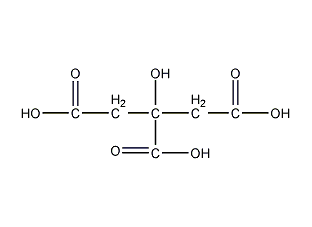
Structural formula
| Business number | 01MF |
|---|---|
| Molecular formula | C6H8O7 |
| Molecular weight | 192.12 |
| label |
2-Hydroxy 1,2,3-propanetrionic acid, β-Hydroxypropanetricarboxylic acid, citric acid, anhydrous citric acid, 3-Hydroxy-3-carboxyglural acid, 2-hydroxy-2-hydroxyglutaric acid, 2-Hydroxy-1,2,3-propanetri-carboxylic acid, β-Hydroxytricarballylic acid, sour agent, sourness modifier, Antioxidant synergist, preservative |
Numbering system
CAS number:77-92-9
MDL number:MFCD00011669
EINECS number:201-069-1
RTECS number:GE7350000
BRN number:782061
PubChem number:24864122
Physical property data
1. Properties: White translucent crystal or powder with a pleasant sour taste.
2. Density (g/mL, 25/4℃): 1.665 (anhydrous)
3. Relative density (20℃, 4℃): 1.665
4. Melting point (ºC): 153 (anhydrous)
5. Crystal phase standard combustion heat (enthalpy) (kJ·mol-1): -1960.6
6. Crystal phase standard claims heat (enthalpy) (kJ·mol-1): -1543.8
7. Refractive index: 1.493~1.509
8. Specific rotation (º): Uncertain
9. Autoignition point or ignition Temperature (ºC): Uncertain
10. Vapor pressure (kPa, 25ºC): Uncertain
11. Saturated vapor pressure (kPa, 60ºC): Uncertain
12. Heat of combustion (KJ/mol): Uncertain
13. Critical temperature (ºC): Uncertain
14. Critical pressure (KPa): Uncertain
15. Log value of oil-water (octanol/water) partition coefficient: Uncertain
16. Explosion upper limit (%, V/V): Uncertain
17. Lower explosion limit (%, V/V): Uncertain
18. Solubility: Easily soluble in water and ethanol, soluble in ether.
19. Flash point (ºC): 100
Toxicological data
1. Acute toxicity
Rat caliber LD50: 3 mg/kg; rat abdominal LD50: 290 mg/kg;
Rat subcutaneous LD50: 5500 mg/kg ;
Mouse caliber LC50: 5040 mg/kg; Mouse abdominal LC50: 903 mg/kg;
Agent. It can also be used as raw materials and additives for cosmetics, metal cleaning agents, mordants, non-toxic plasticizers and boiler anti-scaling agents. Its main salt products include sodium citrate, calcium and ammonium salts, etc. Sodium citrate is a blood anticoagulant, and ferric ammonium citrate can be used as a blood tonic medicine.
It is added to starch adhesive to improve adhesion. It is also an acidity regulator in adhesive production. It is an important raw material for organic synthesis and has a wide range of uses, such as glycerol monoglyceride and potassium salt used to produce citric acid. It is widely used as sour agent, integrating agent, etc. in the food industry. In addition, this product can also be used as an antioxidant synergist, synergist and preservative for compound potato starch bleach.
2.Citric acid has a strong chelating effect. It can complex Fe3+ and weaken the promotion effect of Fe3+ on corrosion. It can remove iron, copper and other metal oxide scales. It is easy and safe to operate and is suitable for a variety of materials. Since there is no CL- in the molecule, it will not cause stress corrosion of equipment and can be used as a cleaning agent. Citric acid has a smaller corrosion rate on steel than hydrochloric acid. Citric acid mainly removes rust and has poor solubility in calcium, magnesium and silicon scale, so it is mainly used to clean newly built large-scale equipment. Citric acid cannot remove calcium magnesium scale and silicate scale. However, citric acid mixed with sulfamic acid, glycolic acid or formic acid can be used to clean rust and calcium magnesium scale. Citric acid mixed with EDTA can be used to clean heat exchangers. . The corrosion inhibitor added to the citric acid cleaning solution is mainly thiourea, with a dosage of 0.1%. You can also use 0.06% thiourea mixed with other corrosion inhibitors. In addition, it can also be used in the medical field. The sodium citrate salt can prevent blood coagulation, the calcium salt can be used as an antacid for the stomach, and the barium salt is toxic. 3.Sour agent, can be used as beverage, candy, canned food and other foods. It has high solubility and strong chelating ability for metal ions. It can also be used as antioxidant synergist, synergist and preservative for compound potato starch bleach.

 微信扫一扫打赏
微信扫一扫打赏

